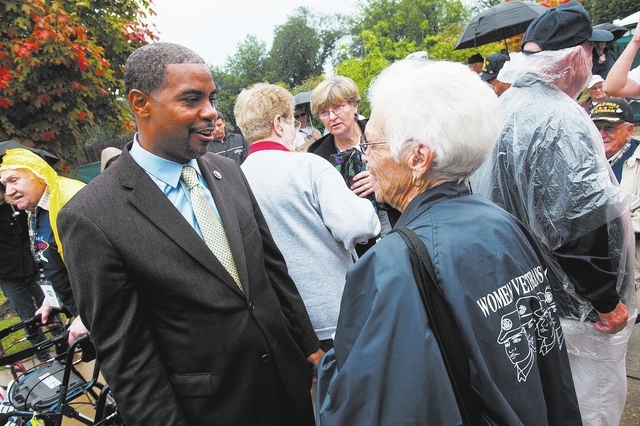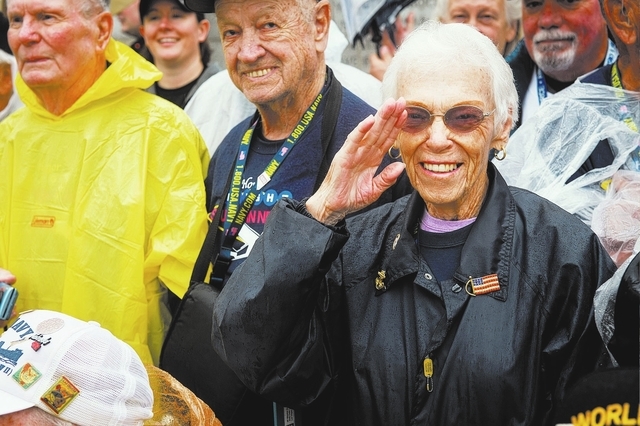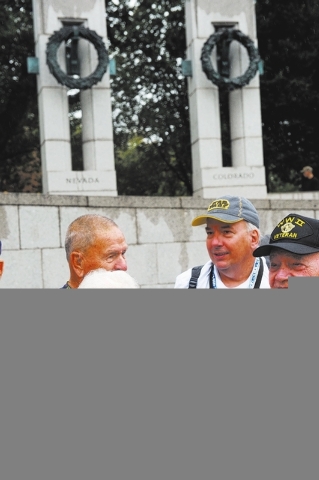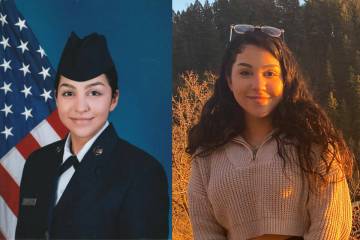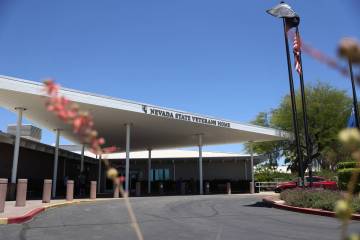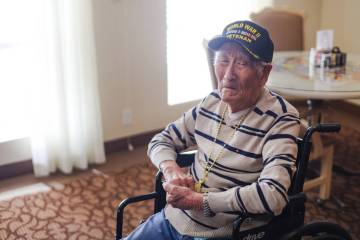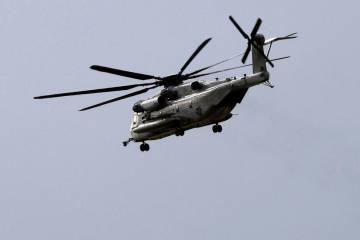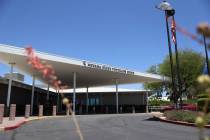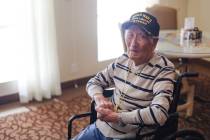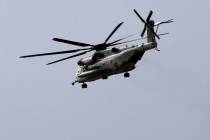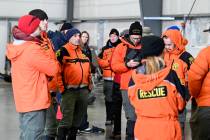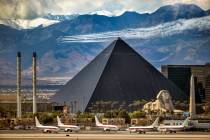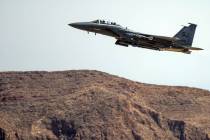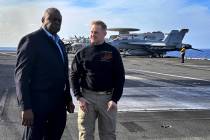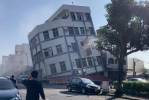Local woman takes Honor Flight
On Oct. 12, Katherine DuPont went to Washington, D.C., with some fellow Southern Nevada World War II veterans to visit the wartime memorials that, for days, had been the subject of controversy because of the government shutdown and their subsequent closure.
But any hitches during the visit can be summed up in the flimsy piece of yellow “caution” tape she brought back as a souvenir.
The barriers were easily ignored and the do-not-enter signs more like a gentle tsk-tsk than a dire warning for the veterans. The only time it got a little shaky was on the road leading to Arlington National Cemetery.
“When we got to the road, somebody had put up large plastic barriers and sitting in front of that was a large vehicle … so four of our guys from our bus got off, cleared the road, pushed the truck to the other side of the road and then our bus driver went ahead, and that’s the way we got into Arlington,” she said.
The trip was made possible by Honor Flight Southern Nevada, a nonprofit group staffed by volunteers and funded through donations, which flies escorted veterans thousands of miles to see the major war monuments in Washington, including the World War II, Korean War and Vietnam War memorials.
It is part of a national Honor Flight Network, which got its start in 2005. Today, there are honor flights from 41 states, and by the end of 2012 more than 98,000 veterans had visited the capital, according to a summary of the program’s history.
The current emphasis for the trips is on veterans from World War II, including the women who served in the U.S. Armed Forces both at home and abroad. For DuPont, the Washington trip was, in many ways, like coming full circle after a fateful decision made 70 years ago.
In 1943, a lieutenant with a newly created Navy division called the WAVES, or Women Accepted for Volunteer Emergency Service, came to speak at her high school in Lindsay, Calif. The WAVES had been created the previous year so that women could volunteer for Navy service and free the men up for combat duty. The WAVES worked in areas such as medicine, communications, science and technology, clerical and aviation.
Although most of her classmates may have thought joining the Naval Reserve was an amazingly bold thing to do, DuPont was sold at “hello.”
“I can see all of us in the auditorium that day and me sitting there, listening to (the lieutenant) and thinking, ‘This is what I want to do,’ ” DuPont said.
She signed up in June of that year and by December she was on her way to six weeks of basic training. It took place at New York’s Hunter College, which had been transformed into a wartime training ground. Suddenly, her days started at 5 a.m. and were full of physical exercise, drills, classes in Naval procedure and “marching everywhere” in the frigid December weather.
It was an experience DuPont soaked up and her superiors noticed. She has a photo of herself from that time, leading a large unit of fellow recruits in their dress blues while they marched in step during a regimental review.
DuPont went on to yeoman training in Stillwater, Okla., for four months and then was transferred to Treasure Island Naval Station in the San Francisco Bay, where WAVES were filling job posts vacated by men shipped overseas. She worked for the command office that put ships into commission, kept track of the vessels while they were in the Pacific Theater and helped ensure they were receiving supplies.
On her first day at Treasure Island, she remembers standing in an office with a view of the bay and looking out at warships as far as the eye could see. The next day DuPont left to spend the weekend with her family, but when she came back the view from that office had changed. All the ships were gone.
“I can remember looking out there and thinking, ‘Oh my gosh, all of those poor men are on their way to fight.’ That was the thing that really got me,” she said.
At the end of 1944, she transferred to Moffett Field to be near her mother who was ill and living in San Jose, Calif., at the time. Moffett Field was a Naval Airship Training Command during World War II, responsible for teaching personnel how to pilot blimps used to spot enemy craft and mines along the West Coast. According to information from the Moffett Field Museum, the crafts were extremely effective, especially in detouring submarines away from Allied ships.
DuPont’s job included keeping track of the military personnel on base and helping with inspections of the blimps. Just like her time at Treasure Island, it was an amazing learning experience about the inner workings of a wartime Navy base.
“The authority we had, to tell you the truth, which we did, being the women and doing the work in the office, was great. I captured every bit of it. I wanted to learn more and that’s what I was doing, I was learning more and more about the Navy because that was going to be my life,” she said.
DuPont, however, would leave the WAVES in 1945. She married a Navy radioman she met while working at Treasure Island. They moved to New York and eventually raised four adopted children.
At one point, her husband, who was in the Reserve, was called to serve in Guam during the Korean War. DuPont’s experience with the WAVES helped her get a civilian office position at a hospital in the U.S. territory. They couple lived there a year, until 1951, in a Navy Quonset hut, she said.
The recent trip to Washington has stirred some old memories for DuPont. She wonders about the soldiers she replaced and what happened to them; whether they died in the war fighting for their country, or survived and went on to lead long, full lives as civilians.
DuPont, who turned 90 on Nov. 9, has also been overwhelmed by the recent response to her service. In October when she strolled the pathways of the memorials, she was wearing a jacket with the words, “Women Veterans of Nevada.” She was stopped about two dozen times by sightseers who asked what she did in World War II and thanked her for the service to her country.
Even in the airports, travelers would see their group of about 35 veterans, many in wheelchairs, and rush up to talk, or wave and yell, “Thank you.”
“It’s been so many years and all of a sudden here I am, almost 90 years old, and all of this is coming back. … It really is nice to think I did something to help somewhere,” she said.



